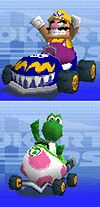(adding/replacing icons from the game and fixing track links.) |
|||
| Line 1: | Line 1: | ||
| − | {{Construction}} |
+ | {{Construction}}[[File:Mario Kart Ds items.png|thumb|220x220px]] |
| + | |||
| − | [[File:Mario Kart Ds items.png|thumb|220x220px]] |
||
{{Videogame |
{{Videogame |
||
|title = Mario Kart DS |
|title = Mario Kart DS |
||
| Line 95: | Line 95: | ||
{| class="wikitable" style="margin: 0 auto; border-radius:5px; width:100%; text-align:center; background:LightGrey; border: 1px solid black;" cellpadding="5" border="1" align="center" 1 " |
{| class="wikitable" style="margin: 0 auto; border-radius:5px; width:100%; text-align:center; background:LightGrey; border: 1px solid black;" cellpadding="5" border="1" align="center" 1 " |
||
| rowspan="6" style="background-color: rgba(207, 226, 244, 1);" width="12%" | |
| rowspan="6" style="background-color: rgba(207, 226, 244, 1);" width="12%" | |
||
| − | ! width="22%" | [[File: |
+ | ! width="22%" | [[File:MKDS_MCup_Icon.png|center|48px]] |
| − | ! width="22%" | [[File: |
+ | ! width="22%" | [[File:MKDS_FCup_Icon.png|center|48px]] |
| − | ! width="22%" | [[File: |
+ | ! width="22%" | [[File:MKDS_StarCup_Icon.png|center|48px]] |
| − | ! width="22%" | [[File: |
+ | ! width="22%" | [[File:MKDS_SpecCup_Icon.png|center|48px]] |
|- |
|- |
||
! <big>Mushroom Cup</big> |
! <big>Mushroom Cup</big> |
||
| Line 106: | Line 106: | ||
|- |
|- |
||
| [[Figure-8 Circuit]] {{Dagger}}<br /> |
| [[Figure-8 Circuit]] {{Dagger}}<br /> |
||
| − | | [[Desert Hills]] |
+ | | [[Desert Hills]]<br /><small>also in ''[[Mario Kart Wii]]''</small> |
| − | | [[DK Pass]] |
+ | | [[DK Pass]]<br /><small>also in ''[[Mario Kart 7]]''</small> |
| − | | [[Wario Stadium]] |
+ | | [[Wario Stadium (DS)|Wario Stadium]]<br /><small>also in ''[[Mario Kart 8]]''</small> |
|- |
|- |
||
| − | | [[Yoshi Falls]] {{Dagger}} |
+ | | [[Yoshi Falls]] {{Dagger}}<br /><small>also in ''[[Mario Kart Wii]]''</small> |
| − | | [[Delfino Square]] |
+ | | [[Delfino Square]]<br /><small>also in ''[[Mario Kart Wii]]''</small> |
| − | | [[Tick |
+ | | [[Tick-Tock Clock]] {{Double-dagger}}<br /><small>also in ''[[Mario Kart 8]]''</small> |
| − | | [[Peach Gardens]] {{Double-dagger}} |
+ | | [[Peach Gardens]] {{Double-dagger}}<br /><small>also in ''[[Mario Kart Wii]]''</small> |
|- |
|- |
||
| − | | [[Cheep Cheep Beach]] {{Dagger}} |
+ | | [[Cheep Cheep Beach]] {{Dagger}}<br /><small>also in ''[[Mario Kart 8]]''</small> |
| − | | [[Waluigi Pinball]] {{Double-dagger}} |
+ | | [[Waluigi Pinball]] {{Double-dagger}}<br /><small>also in ''[[Mario Kart 7]]''</small> |
| − | | [[Mario Circuit]]<br /> |
+ | | [[Mario Circuit (DS)|Mario Circuit]]<br /> |
| − | | [[Bowser |
+ | | [[Bowser Castle (DS)|Bowser Castle]] {{Double-dagger}}<br /> |
|- |
|- |
||
| − | | [[Luigi's Mansion]] {{Dagger}} |
+ | | [[Luigi's Mansion (track)|Luigi's Mansion]] {{Dagger}}<br /><small>also in ''[[Mario Kart 7]]''</small> |
| [[Shroom Ridge]] {{Double-dagger}}<br /> |
| [[Shroom Ridge]] {{Double-dagger}}<br /> |
||
| − | | [[Airship Fortress]] {{Double-dagger}} |
+ | | [[Airship Fortress]] {{Double-dagger}}<br /><small>also in ''[[Mario Kart 7]]''</small> |
| − | | [[Rainbow Road]]<br /> |
+ | | [[Rainbow Road (DS)|Rainbow Road]]<br /> |
|} |
|} |
||
===Retro tracks=== |
===Retro tracks=== |
||
{| class="wikitable" style="margin: 0 auto; border-radius:5px; width:100%; text-align:center; background:LightGrey; border: 1px solid black;" cellpadding="5" border="1" align="center" 1 " |
{| class="wikitable" style="margin: 0 auto; border-radius:5px; width:100%; text-align:center; background:LightGrey; border: 1px solid black;" cellpadding="5" border="1" align="center" 1 " |
||
| + | | rowspan="6" style="background-color: rgba(207, 226, 244, 1);" width="0%" | |
||
| + | ! width="0%" | |
||
| + | ! width="22%" | [[File:MKDS_ShellCup_Icon.png|center|48px]] |
||
| + | ! width="22%" | [[File:MKDS_BCup_Icon.png|center|48px]] |
||
| + | ! width="22%" | [[File:MKDS_LeafCup_Icon.png|center|48px]] |
||
| + | ! width="22%" | [[File:MKDS_LightCup_Icon.png|center|48px]] |
||
|- |
|- |
||
! <big>System</big> |
! <big>System</big> |
||
| Line 136: | Line 142: | ||
|- |
|- |
||
| SNES<br /> |
| SNES<br /> |
||
| − | | [[ |
+ | | [[Mario Circuit 1]] {{Dagger}}<br /> |
| [[Donut Plains 1]] {{Double-dagger}}<br /> |
| [[Donut Plains 1]] {{Double-dagger}}<br /> |
||
| [[Koopa Beach 2]] {{Double-dagger}}<br /> |
| [[Koopa Beach 2]] {{Double-dagger}}<br /> |
||
| Line 145: | Line 151: | ||
| [[Frappe Snowland]]<br /> |
| [[Frappe Snowland]]<br /> |
||
| [[Choco Mountain]]<br /> |
| [[Choco Mountain]]<br /> |
||
| − | |[[Banshee Boardwalk]] {{Double-dagger}}<br /> |
+ | | [[Banshee Boardwalk]] {{Double-dagger}}<br /> |
|- |
|- |
||
| GBA<br /> |
| GBA<br /> |
||
| [[Peach Circuit]] {{Dagger}}<br /> |
| [[Peach Circuit]] {{Dagger}}<br /> |
||
| − | | [[Bowser |
+ | | [[Bowser Castle 2 (GBA)|Bowser Castle 2]] {{Double-dagger}}<br /> |
| − | | [[Luigi Circuit]]{{Double-dagger}}<br /> |
+ | | [[Luigi Circuit (GBA)|Luigi Circuit]] {{Double-dagger}}<br /> |
| [[Sky Garden]]<br /> |
| [[Sky Garden]]<br /> |
||
|- |
|- |
||
| GCN<br /> |
| GCN<br /> |
||
| − | | [[Luigi Circuit]] {{Dagger}}<br /> |
+ | | [[Luigi Circuit (GCN)|Luigi Circuit]] {{Dagger}}<br /> |
| − | | [[Baby Park]] |
+ | | [[Baby Park]]<br /><small>also in ''[[Mario Kart 8|8 Deluxe]]'' (or ''8'' DLC)</small> |
| − | | [[Mushroom Bridge]] |
+ | | [[Mushroom Bridge]] |
| + | {{Double-dagger}}<br /> |
||
| − | | [[Yoshi Circuit]] |
+ | | [[Yoshi Circuit]]<br /><small>also in ''[[Mario Kart 8|8 Deluxe]]'' (or ''8'' DLC)</small> |
|} |
|} |
||
| Line 168: | Line 175: | ||
| <small>N64</small> [[Block Fort]] |
| <small>N64</small> [[Block Fort]] |
||
|- |
|- |
||
| − | | [[Twilight House]] |
+ | | [[Twilight House]]<br /><small>also in ''[[Mario Kart Wii]]''</small> |
| <small>GCN</small> [[Pipe Plaza]] {{Dagger}} |
| <small>GCN</small> [[Pipe Plaza]] {{Dagger}} |
||
|- |
|- |
||
| Line 304: | Line 311: | ||
==External Links== |
==External Links== |
||
*[http://www.mariokart.com/mkds/launch/index.html The Official Mario Kart DS Website] |
*[http://www.mariokart.com/mkds/launch/index.html The Official Mario Kart DS Website] |
||
| + | |||
{{Games/nav}} |
{{Games/nav}} |
||
| ⚫ | |||
[[Category:Games]] |
[[Category:Games]] |
||
[[Category:Handheld console games]] |
[[Category:Handheld console games]] |
||
[[Category:Mario Kart DS|*]] |
[[Category:Mario Kart DS|*]] |
||
[[Category:Mario Kart series]] |
[[Category:Mario Kart series]] |
||
| ⚫ | |||
Revision as of 15:42, 27 June 2018

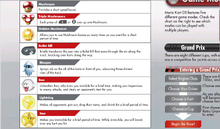
Mario Kart DS (styled as MARIOKART DS and abbreviated to MKDS), is a Nintendo DS racing game developed and published by Nintendo. It is the fifth installment in the Mario Kart series and the first to use Nintendo's free online service, Nintendo Wi-Fi Connection (now discontinued). The game was released in 2005. It was well received critically, scoring an average of 91% from Metacritic. Many reviewers have called it the best Mario Kart game in the series.
Like other games in the Mario Kart series, Mario Kart DS involves various characters from various Mario games racing each other in go-karts on tracks themed from locations in the Mario series, less realistic physics, and the use of various weapons and or items to achieve victory differentiates kart racing games like Mario Kart DS from more realistic racing games. For US, Europe, Australia, and Japan it released in 2005, apparently, if you live in Korea, you had to wait until 2007.
Gameplay
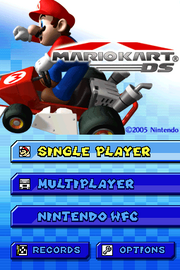
The Title Screen
In Grand Prix mode, the player competes against seven computer-controlled racers. There are two types of Grand Prix in Mario Kart DS, each consisting of four cups, and each cup consisting of four race tracks. Nitro GP contains sixteen brand new tracks while Retro GP contains sixteen tracks converted from previous entries in the Mario Kart series. There are three engine classes which serve as difficulty levels for the Grand Prix mode: 50cc, 100cc, and 150cc. The higher the engine class, the faster all the karts go. A 150cc Mirror Mode is also an unlockable, in which all the 150cc tracks are flipped horizontally, as if seeing the game in a mirror.
Another staple of past Mario Kart games, Battle Mode, also makes a return. Battle modes include Balloon Battle, in which you try to pop everyone else's balloons by attacking them or steal them with mushrooms and eliminate them, or Shine Runners, in which you try to collect the most Shine Sprites. Eventually, players with the least amount of Shine Sprites will be eliminated from the game.
Items also appear in the DS sequel. There are old items such as Bananas and Green Shells. There are also new Items such as Blooper and Bullet Bill.
In the new Mission Mode, players control a specific character in that character's standard kart, and must perform eight individual missions, whose objectives range from collecting coins to attacking enemies. Players are then ranked based on their performance, and given either an E, D, C, B, A, or one to three stars if the task is completed by a certain time. In order to advance to the next level, players must complete a "boss" task, which is unlocked after all eight of a level's missions are completed. Completing all missions in level 1 through 6 with at least a 1 star rating on each mission opens up a secret 7th level with more challenging missions to complete. It should be noted that there are no missions where one of the unlockable characters is playable.
In Time Trial Mode, players try to finish a course in a short time as possible.
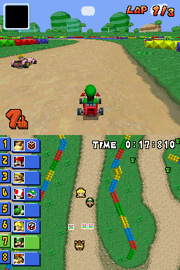
The racing interface.
While racing, the top screen of the Nintendo DS displays a third-person perspective behind and slightly above the player's vehicle. The bottom screen lists the current race standings, items carried by each player, and a map of the course. The map can be toggled to show an overall view of the entire course, or a close-up view of the racer's immediate vicinity. The close-up view is very detailed, showing nearby racer positions, course hazards, item boxes, and even incoming attacks.
Each playable character starts out with two karts: one special kart unique to that character, and a standard kart resembling a real go-kart. These karts have slightly different stats, although their general strengths and weaknesses are the same. As a player progresses through the game, he or she can unlock a third special kart for each character, also with slightly different stats. Ultimately, the player can unlock the ability to use any of the 36 total karts with any character. When a player is selecting their kart for a race, the game lists the kart's max speed, acceleration, weight, handling, drifting ability, and the quality of items the kart is likely to receive.
Each course features numerous item boxes that players can drive through to receive a randomly-selected item. Whichever item the player receives is generally dependent upon their current position in the race and, to a lesser extent, the item stat of the player's kart; Players near the front will tend to receive rear-attack items, while players trailing in the back of the race will tend to receive more powerful items. Most attack items can be targeted forwards or backwards by holding the appropriate direction on the D-pad when using the item against other. New items like Bullet Bill transformation have also been added in the game.
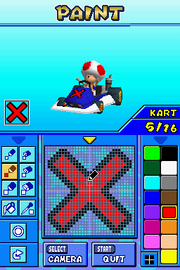
The emblem editor.
Mini-Turbos, a feature first introduced in Mario Kart: Double Dash!!, returns in Mario Kart DS. Mini-Turbos are momentary speed boosts that can be obtained while drifting. Also featured in Mario Kart DS and not to be confused with drifting is the ability to draft behind an opponent's kart. If the player is close enough, white streaks will start flying by their kart, and their speed will begin to increase. If the player maintains this position long enough, they will receive a noticeable speed boost, allowing them to easily overtake and pass the opponent, which is called drafting. The Rocket Start technique for starting a race also returns for this installment, but with a small change: players can now hold the acceleration button when the countdown timer shows 2.
Using a simple drawing program interface, a player can create a customized emblem. During the race, each player's emblem appears as a decal on their kart, and in multi-player matches, opponents can see the player's name and emblem prominently overlaid above their kart's position on the opponent's screen. The player's emblem is also, on Wi-Fi play, shown to their opponents once the Nintendo Wi-Fi Connection has found opponents and initiated a match.
Wi-Fi Multiplayer
This normally includes only 20 racing tracks and only the VS. racing mode.
There is an eight player limit, and has modes such as VS., Balloon Battle and Shine Runners.
When choosing players, you are restricted to 8 characters (Mario, Luigi, Peach, Yoshi, Toad, Donkey Kong, Wario and Bowser).
Multi-Card Multiplayer
If each member of a group has a Nintendo DS and a copy of Mario Kart DS, it is possible to race in Multi-Card mode. All of the game's characters and tracks are available, and Battle mode can be selected for multiplayer.
With the Mario Kart DS demo available from Volume 1 of DS Download Station, only Multi-Card Multiplayer mode is available. Although no physical game is used, each player must download the demo from the Station. Once this is finished, VS. mode can be accessed for play on the Figure-8 Circuit track and SNES Mario Circuit 1 track. Only differently-colored Shy Guys are available as characters, some which will be controlled by the computer for games with less than eight players.
Single-Card Multiplayer
Single-Card Multiplayer mode allows racing for up to eight players with one DS-compatible console per player and only one copy of Mario Kart DS. The first player selects the game's Multiplayer mode, while the others select "DS Download Play" on their handheld. Only eight tracks are available in this mode: those of the Mushroom Cup and those of the retro Shell Cup. All players are differently-colored Shy Guys.
Racers
There are 13 characters in Mario Kart DS, ten are from previous Mario Kart games and three of them are new to the series, which are Dry Bones, Shy Guy, and R.O.B. However, Shy Guy is not directly playable, and you can only play as him by doing a simple multiplayer match and downloading off someone else using Download Play. Shy Guy is also the only CPU player in the Mario Kart Nintendo DS Download Kiosk demo, available from version 1 of the USA kiosk, however the player will race against seven differently colored Shy Guys at once in the single player mode.
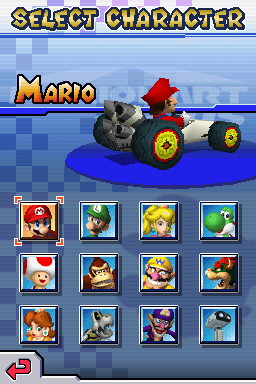
The Character select screen with all characters unlocked.
Default racers
- Mario (Medium)
- Luigi (Medium)
- Peach (Light)
- Toad (Light)
- Yoshi (Light)
- Bowser (Heavy)
- Donkey Kong (Heavy)
- Wario (Heavy)
Unlockable racers
Download Play Only racers
- Shy Guy (Light)
Tracks
This is the second game in the Mario Kart series to return previous tracks in addition to never-before-seen tracks, the first game being Mario Kart: Super Circuit which featured all 20 tracks from Super Mario Kart.
![]() indicates a track or course available in all multiplayer modes, including single-card mode.
indicates a track or course available in all multiplayer modes, including single-card mode.
![]() indicates a track unavailable in the now-discontinued Nintendo WFC mode.
indicates a track unavailable in the now-discontinued Nintendo WFC mode.
Nitro tracks
| Mushroom Cup | Flower Cup | Star Cup | Special Cup | |
|---|---|---|---|---|
| Figure-8 Circuit |
Desert Hills also in Mario Kart Wii |
DK Pass also in Mario Kart 7 |
Wario Stadium also in Mario Kart 8 | |
| Yoshi Falls also in Mario Kart Wii |
Delfino Square also in Mario Kart Wii |
Tick-Tock Clock also in Mario Kart 8 |
Peach Gardens also in Mario Kart Wii | |
| Cheep Cheep Beach also in Mario Kart 8 |
Waluigi Pinball also in Mario Kart 7 |
Mario Circuit |
Bowser Castle | |
| Luigi's Mansion also in Mario Kart 7 |
Shroom Ridge |
Airship Fortress also in Mario Kart 7 |
Rainbow Road |
Retro tracks
| System | Shell Cup | Banana Cup | Leaf Cup | Lightning Cup | |
|---|---|---|---|---|---|
| SNES |
Mario Circuit 1 |
Donut Plains 1 |
Koopa Beach 2 |
Choco Island 2 | |
| N64 |
Moo Moo Farm |
Frappe Snowland |
Choco Mountain |
Banshee Boardwalk | |
| GBA |
Peach Circuit |
Bowser Castle 2 |
Luigi Circuit |
Sky Garden | |
| GCN |
Luigi Circuit |
Baby Park also in 8 Deluxe (or 8 DLC) |
Mushroom Bridge
|
Yoshi Circuit also in 8 Deluxe (or 8 DLC) |
Battle courses
| Nitro | Retro |
|---|---|
| Nintendo DS |
N64 Block Fort |
| Twilight House also in Mario Kart Wii |
GCN Pipe Plaza |
| Palm Shore | N/A |
| Tart Top |
N/A |
In single-card mode, battle courses are selected at random instead of displaying the course selection screen.
Items
- Banana Peel/Triple Banana
- Green Shell/Triple Green Shell
- Red Shell/Triple Red Shell
- Spiny Shell
- Fake Item Box
- Star
- Lightning
- Boo
- Blooper (New Item)
- Bullet Bill (New Item)
- Mushroom/Triple Mushroom
- Golden Mushroom
- Bob-omb
Beta Elements
This is a list of beta elements in Mario Kart DS.
Items
The Chain Chomp and the Bowser Shell from Mario Kart: Double Dash!! were supposed to appear in the game (like in the kiosk demo) but they were removed because they were too powerful. However, these items still remain in the game's coding, and if you use the Chain Chomp or the Bowser Shell, the game will crash.
Courses
- Donkey Course (filename: donkey_course) : The early version of DK Pass. The course was supposed to be a grassy mountain, but it was covered with snow in the final. This course also had Goombas and Thwomps which do not relate to snow-themed courses.
- GCN Mario Circuit was going to be a retro course but was not used in the end. Instead it appeared in Mario Kart Wii.
- GCN Block City was going to be a retro battle course but was not used in the end.
- Dokan_Course (unnamed) : A collision test course.
- test1_course : A course used possibly to test the environment of some courses.
- test_circle : Self-explanatory.
Karts
Yoshi and Wario have two unused karts.
Wario's car was blue with a yellow mustache. Yoshi's looks like the Egg 1, but it's pink. It is called the Egg 2.
Characters
Professor E. Gadd, Birdo, Toadette, and Koopa Troopa were all planned to appear as unlockable playable characters but were removed at some point for unknown reasons and were presumably replaced by Dry Bones, Daisy, Waluigi, and R.O.B.
Karts
There are thirty-six karts in Mario Kart DS. They are classified based on six stats which are:
- Speed: Speed determines how fast the player's kart will go.
- Acceleration: Acceleration determines how much time it will take for the kart to reach its full speed.
- Weight: Weight determines how well it will withstand getting pushed or how far it can push others.
- Handling: Handling shows how well the kart can turn without drifting.
- Drift: Drift shows how tight the player's kart will drift.
- Items: Items show how many mushrooms the player will have in Time Trials (one, two, or three).
Kart List
Each character has three karts, two of which are available from the start.
Obstacles and Hazards
Mario Kart DS has obstacles in almost every course which are:
- Boxes: You'll find wooden boxes throughout the game. Once you crash into a box, it will explode, making you stop, plus, sometimes an item will come out of one once you crash into it. They're featured in Mission 2-1.
- Cheep-Cheep: Cheep-Cheeps are swimming around in the water, so it's easy to dodge them since you usually don't have to go there.
- Sidestepper: You'll find Sidesteppers on Cheep Cheep Beach, if you run into one, you will suddenly start to spin around for a couple of seconds. This could tragically put you in last place on the account that they are near the end of the level.
- Monty Mole: You'll find Monty Moles on multiple courses such as Peach Gardens. You will see small holes in the ground, sometimes, Monty Moles will pop out of the holes and try to spin you out. They can also be found in Moo Moo Farm, where they were formerly known as "Chubbies".
- Piranha Plant: Piranha Plants will appear in a couple of courses. In Mario Circuit, they will pop out of their pipe and try to spit out fire balls at you.
- Pokey: You'll find Pokies on the Desert Hills track. They will be swaying back and forth in one spot. If you crash into one, you'll fly in the air and come back down to the ground, putting off a few seconds of the racing time.
- Rocky Wrench: You'll find Rocky Wrenches on the Airship Fortress stage. On this stage, the moles will pop out of the sewers on the ship. Though they don't throw wrenches at you like they do in Super Mario Bros. 3, you can still be harmed if you run into them.
- Chain Chomp: You'll find it in GCN Luigi Circuit and Peach Gardens. When you get close at it, it will run up to you and bark at you.
- Podoboo: You'll find it in the Desert Hills track. In the second round, the sun will spit them, what they do, is that they jump around and try to burn you.
- Flamethrowers: You'll find them the tracks Airship Fortress and Bowser's Castle.
- Banzai Bill: You'll fin them in Airship Fortress. They go in one direction to hit you.
- Pin-Balls: You'll find them in Waluigi Pinball. They cause huge impact on you.
- Bats: You'll find them in N64 Banshee Boardwalk. They are really annoying and come out of treasure chests.
- Vehicles: These appear in Shroom Ridge and GCN Mushroom Bridge and will cause you to flip and lose all your items if you hit them.
- Mr Blizzards: They are found in DK Pass and N64 Frappe Snowland. They explode upon impact.
Emblems
This is the newest feature of the game. This only appears in this game. An emblem is a decal or picture that appears as a sort of symbol for someone on their kart. The emblem appears only on certain places on a kart, and depending on where it is put, the emblem may be smaller, bigger and/or stretched out. The player also has the ability to choose from various patterns ranging from a Starman to Thunderbolt and also the shape of Mario's face. The player also can choose not to use a custom emblem and to use an original emblem already designed for the a character. The player might do this if he/she has an unfinished emblem that they don't want others to see. Emblems are displayed during VS matches and in online matches on the Nintendo Wi-Fi Connection.
Tie-ins With Other Games
- Super Mario Kart: Mario Kart DS features the bottom map screen from Super Mario Kart.
- Mario Kart 64: Mario Kart DS features 3-dimensional tracks that first appeared in Mario Kart 64.
- Mario Kart Super Circuit: Mario Kart: Super Circuit and Mario Kart DS were both made for a portable system and both have the Lightning Cup as well as retro courses.
- Mario Kart: Double Dash: Mario Kart: Double Dash and Mario Kart DS both feature unlockable characters.
- Mario Kart Wii: Mario Kart DS and Mario Kart Wii both feature retro courses.
- Mario Kart 7: Mario Kart DS and Mario Kart 7 both are for a portable system, feature the bottom screen map and they both have retro courses.
- Mario Kart 8: Players who lose Balloon Battle are also able to continue playing until it ends in this game. Mario Kart DS and Mario Kart 8 both have retro courses.
- All games released before Mario Kart DS supply retro courses to this game.
Critic Reviews
- Mario Kart DS still maintains a 9.2 average at Gamestats, #1 on the Nintendo DS (as of 15:40, 22 December 2006 (EST)).
- Gamespy reviewer Bryn Williams admitted that online, Nintendo "trimmed it back a little too much for my liking", but was certain that "Even with a few online flaws, this is the best Mario Kart ever.." (5/5; Multiplayer: Great)
- Gamespot reviewer Justin Calvert had similar quips with the online feature: "Whether these opponents were leaving voluntarily or because of network problems is anybody's guess, but it's equally irritating either way." Yet, he finished up similarly by saying "Mario Kart DS is without a doubt one of the best games to hit the Nintendo DS to date." (9.2/10; GameSpot Editor's Choice; DS Game of the Year)
- IGN reviewer Craig Harris commented that "it's just hard to ignore just how limited the online presentation is." But again, his closing line was this: "The only way to finish this review is just to say it: this is the greatest Mario Kart game ever developed, and is without a doubt the best DS game of 2005." (9.5/10; IGN Editor's Choice Award; DS Game of the Year)
Scores received in the major gaming review sites:
- Gamerankings - 93%
- GameSpot - 9.2/10
- IGN - 9.5/10
- Joystiq - 9.0/10
- Nintendo Power - 9.0/10
Trivia!
- In the American version of the game, R.O.B. is green and brown and has the name FR, or better known as Famicom Robot, is the original Japanese version of R.O.B. Additionally, R,O.B is the true staff ghost on Waluigi Pinball and Bowser Castle, not F.R (thus the * in the table above). R.O.B has the same karts as F.R, even down to the same coloration.
- Mario Kart Slot Cars were created as a promotion for this game.
- During the race when a character gets the item box, the item-roulette sound effect stop selection was "Blah". The item-roulette sound effect carries over to Mario Kart Wii.
- When players play Mario Kart DS on different DS systems, Mario's title dialogue will change. When playing on an original DS and Nintendo 3DS (Old, New), he will say "Wahoo!", but on DS Lite/DSi, he will say "Here we go!".
- The American version of Mario Kart DS is one of the earliest games on the DS to have a multiple language option (almost all European DS games have this function, though). Depending on the language of the DS, the language on the game will change; however, it will not change into Japanese.
- Mario Kart DS is one of the first games to be released that was compatible with the Nintendo Wi-Fi Connection, allowing players to go online and race against other users around the world.
- A player's overall game ranking (*, **, or *** stars, if achieved) will appear next to his or her name online while racing.
- Mario Kart: Super Circuit tie-in: When the Nintendo DS is turned on with "Mario Kart DS" in Slot 2 and "Mario Kart: Super Circuit" in Slot 3, "Super Circuit" is listed as an "Option Pack" and cannot be played. Users have yet to discover if and how this effects "Mario Kart DS".
- This game standardized the retro cup system (Shell, Banana, Leaf, Lightning).
- In the PAL version of the game, 'Bowser's Castle' was written as 'Bowser Castle'. It is unknown whether this was accidental or intentional.
- In the Mario Kart DS beta. when you use a Chain Chomp or Bowser Shell, the game will crash.
- The Boo, a returning item in this game, was removed in Mario Kart Wii, probably in favor for the new Thunder Cloud item.
- The Blooper, as well as the Banana and Lightning, led to the POW Block being introduced in Mario Kart Wii.
- This game is R.O.B.'s only ever appearance so far.
- This is the only Mario Kart game to have two different Luigi Circuits at once in the retro cups. They are GBA and GCN versions, respectively.
External Links
| Mario Kart games | |
|---|---|
| Main Titles | Super Mario Kart (1992, SNES) • Mario Kart 64 (1996, N64) • Mario Kart: Super Circuit (2001, GBA) • Mario Kart: Double Dash!! (2003, GameCube) • Mario Kart DS (2005, DS) • Mario Kart Wii (2008, Wii) • Mario Kart 7 (2011, 3DS) • Mario Kart 8 (2014, Wii U) • Mario Kart 8 Deluxe (2017, Switch) |
| Arcade Titles | Mario Kart Arcade GP (2005) • Mario Kart Arcade GP 2 (2007) • Mario Kart Arcade GP DX (2013) • Mario Kart Arcade GP VR (2017) |
| Spin-off Titles | Mario Kart Tour (2019, Mobile) • Mario Kart Live: Home Circuit (2020, Switch) |
|}


